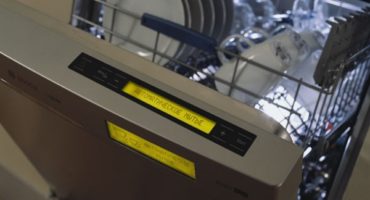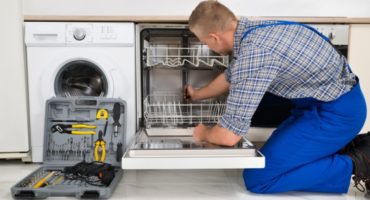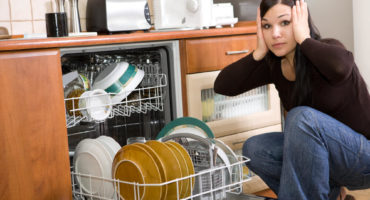Nowadays it is difficult to imagine life without household appliances. Items such as a washing machine, dishwasher and many others are an integral part of modern everyday life.
There is a common misconception about the inefficiency of dishwashers. At first, it may really seem that the equipment is not coping with the task. However, the dishwasher is easy to learn, and after 2-3 cycles the user will be much better able to understand what and where to press and how to use the machine, so that the effect is exactly what is expected.
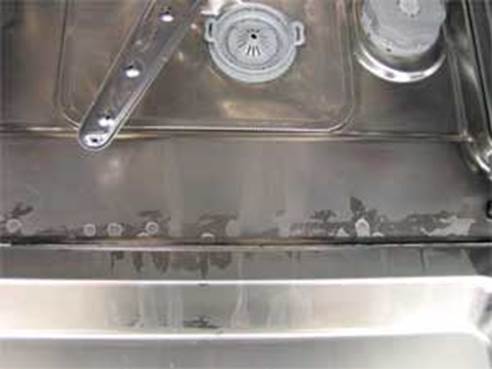
Dishwashers require tablets containing the substances necessary for washing, as well as salts that soften the water and bring it to the desired hardness index. This is necessary for the normal operation of the equipment.
Quite often on the dishes after washing in the dishwasher there is a white coating. Stains can settle on pots, plates, or inside the dishwasher itself. White plaque and stains not only spoil the appearance of the dishes and the machine itself, but also contain a threat to the equipment. Below will be discussed in detail causes of plaque and countermeasures.
First reason: scale due to water hardness
Tap water contains many impurities, including mineral salts. When heating the entire water mass, the particles begin to settle inside the filled tank. Scale settles in pipes, on machine parts, sometimes on dishes. Gradually accumulating, mineral salts form a white coating inside the dishwasher.
Scale is the most common cause of damage to washing machines and dishwashers. Repair in this case is difficult, and sometimes impossible. Therefore, the best strategy is to prevent the appearance of scale. To do this, manufacturers of dishwashers equipped all devices with an ion exchanger. This compartment is responsible for softening the water with a special resin. A special substance must be periodically added to the tank. This will help prevent scale formation.

At first, the lack of salt is uncritical. The first three to four cycles, the ion exchanger copes with the task of softening water hardness in the dishwasher. However, after the supply of resin is gradually depleted, and with each new launch to soften the water becomes more difficult. Scale gradually accumulates inside the dishwasher and, as a result, leads to equipment breakdown. To avoid this, try to keep salt with you.
How much salt to pour in the dishwasher and why it is needed, you can find out by clicking on the link.
Modern dishwashers are equipped with a dosing system that allows the use of salt to soften water in strictly defined doses. The amount of substance required for use depends on the level of water hardness. This indicator can be measured using a special examination. However, it is unlikely that users of dishwashers have the time and money for such measures. Therefore, it will be most reliable to purchase a dishwasher equipped with a sensor that shows the level of water hardness. Thanks to it, you can accurately calculate the amount of salt needed for use and avoid unnecessary waste of a substance to soften water.
Note! Some models are equipped with an automatic program for selecting the cycle and the release of salt in accordance with the level of water hardness.
Second reason: quality and dosage level of detergents
White coating inside the dishwasher or on dishes may also be residual residue from detergents. Stains and stains in this case remain at all places where the surface is embossed.
White coating inside the dishwasher or on the surface of the dishes may remain for various reasons. The main ones are three:
- Poorly washed powder due to insufficient rinsing.
- The tablet is not sufficiently dissolved in water due to low temperature or the lack of water pumped into the tank.
- No rinse aid. There may also be an excess or deficit. Pour in a strictly dosed amount.
In the first case, the powder is poorly washed off and leaves streaks if it is poured too much. But even with dosed use, plaque may remain due to a lack of rinse aid, or if the powder itself is of poor quality. To avoid stains, use a rinse aid, and in strictly dosed quantities. If the rinse aid has been used too much, a greasy oily sheen will appear on the dishes and inside the dishwasher. Residues from the chemicals that make up the detergent will settle on the surface.
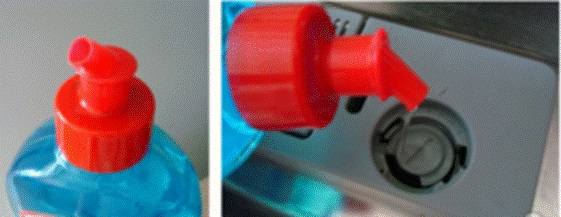
Sometimes users dishwasher pour rinse aid in one compartment with washing powder. In this case, the rinse aid is washed at the final stage of washing the dishes, and the remaining chemical elements settle in the hopper or on the dishes. Remember: do not pour rinse aid in one compartment with powder. Each means has a separate compartment.
If these measures are not followed, a white coating will appear. In this case, it is better to rinse the dishes under the tap, and wipe the inside of the machine with a damp cloth.

In this case, it is worth noting that when using tablets, the risk of plaque is significantly lower than from a powder or rinse aid. Tablets usually contain a metered amount of all the necessary substances. However, the pill is not a panacea for white plaque. Poor quality pills can have the same effects as other detergents. The reason for this may also be the level of water hardness. In this case, alkalis enter into a chemical reaction with mineral salts and can settle in the form of plaque or film. Do not forget to add salt to the ion exchanger for prevention!
It's important to know! For the dishwasher, cleaning powders and liquid gels for manual dishwashing are not suitable. They are not compatible with the equipment and their use can lead not only to the appearance of a raid, but also to the failure of equipment.
Sometimes the cause of a raid can be salt that accidentally enters the hopper during washing. We recommend that you close the lid of the salt compartment softening the water through the ion exchanger.
Third reason: technical malfunctions, or violations of the operating rules
The third reason may be technical problems. A low level of plugs or poor flushing of compartments can also be a cause of a raid. Malfunctions can be of the following type:
- Jammed compartment lids. A tablet or powder can spill out of the compartment and enter the hopper of the dishwasher. Their particles do not dissolve in water and, as a result, are poorly washed out when rinsing.
- One of the filters is clogged. Each dishwasher is equipped with several filters for cleaning water when pumping it into the tank, as well as filtering the drained water from food particles or dirt.
- Pressure reduction in valves during water injection as a result of clogged holes in the spray gun.
These problems are easily fixed on their own, without the involvement of repairmen. Regardless of the "age" and frequency of use of the dishwasher, it is necessary to take it apart twice a year and rinse the filters thoroughly. A necessary measure is also a “single” washing with a special tool. The machine starts up empty.This is necessary to flush the hopper and eliminate streaks and deposits inside.

If you find a problem with the compartment lid, then this part can either be replaced or filed to the desired size with a file. Critical weight may also be a cause of jamming of the lid. Each model of dishwasher has its own maximum allowable weight of dishes loaded into the hopper.
Most machines are equipped with an alarm sensor squealing if a critical mass has accumulated in the hopper.
Conclusion
In this material, the main reasons for the occurrence of white plaque in the hopper of the dishwasher, or on the dishes themselves were given. The problem is quite common, so try to follow all preventive measures.
Regardless of the level of hardness of the water and the frequency of use of the dishwasher, it is recommended to wash the machine and clean the filters twice a year, no matter how badly they are dirty.
Subject to all safety precautions, the dishwasher will serve you for many years. The main thing is to follow the operating rules and periodically inspect spare parts.

